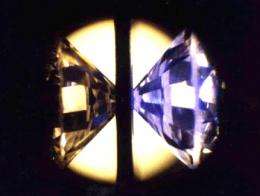Hydrogen-rich Material Promises Advances in Energy Transmission, Fuel Storage

(PhysOrg.com) -- Researchers at the Stanford Institute for Materials and Energy Science, a joint institute of SLAC and Stanford University, have produced a hydrogen-rich alloy that could provide insight into the properties of metallic hydrogen, according to a study published in the August 17 issue of Proceedings of the National Academy of Sciences. The work is a step toward materials with revolutionary implications for energy science, enabling lossless power transmission, next-generation particle accelerators and even magnetic levitation.
Metallic hydrogen is a state of hydrogen predicted to form under ultra-high pressure. If achieved, some researchers predict it could function as a room-temperature superconductor—a material capable of conducting electricity with zero resistance at temperatures above 0 degrees Celsius. But because the pressure required to make metallic hydrogen is so enormous—much greater the pressure experienced by materials in the center of the earth—researchers have had little luck in producing it.
"People are very interested in hydrogen because it's element one," said SIMES physicist Wendy Mao, who was a co-author on the study. "At high enough pressure, it should be metallic and it should be a room temperature superconductor."
In hopes of getting a better idea of how metallic hydrogen behaves, researchers are becoming increasingly interested in hydrogen-rich compounds that might have properties similar to those seen in pure hydrogen. Called hydrides, the chemicals might undergo similar phase changes as metallic hydrogen, but at more accessible pressures.
One of the most promising candidates of study is called silane, which contains an atom of silicon bound to four atoms of hydrogen. Previous studies have suggested that pure silane metalizes at pressures far lower than those required to produce metallic hydrogen. The goal for Mao's group was to study the properties of alloys composed of hydrogen and silane together.
"People have already identified pure silane as a superconductor," she said. "The next step is to determine what happens if you have something that is mostly hydrogen with a little bit of silane. Maybe you can get something closer to hydrogen."
For the study, Mao and her colleagues studied two different silane-containing samples: one containing equal parts hydrogen and silane, another containing an abundance of hydrogen in a five-to-one ratio.
Using a device called a diamond anvil cell, the samples were squeezed between a pair of diamonds, generating pressures upwards of 6 gigapascals—60,000 times the earth's atmospheric pressure at sea level. Aside from being one of the few materials suited to withstand the high pressures, diamond also provides researchers a window into the process, allowing them to conduct analyses of the pressurized samples.
The alloys solidified at much lower pressures than would be required for hydrogen alone, with the hydrogen-rich alloy forming a solid containing more than 99 percent hydrogen.
The researchers also found that even though the amount of silane in the hydrogen-rich sample was minimal, it had a dramatic effect on hydrogen-hydrogen interactions. According to Shibing Wang, a SIMES graduate student and the lead author on the paper, the finding is significant because it could contribute to a better understanding of the properties of atoms in hydrogen alloys, which are commonly used in hydrogen storage and could have implications for hydrogen fuel storage.
"The interaction between hydrogen and its environment is definitely more complicated than we expected," Wang said. "I'm quite sure this is true for other hydrides that have potential hydrogen storage capabilities."
Provided by SLAC National Accelerator Laboratory (news : web)

















